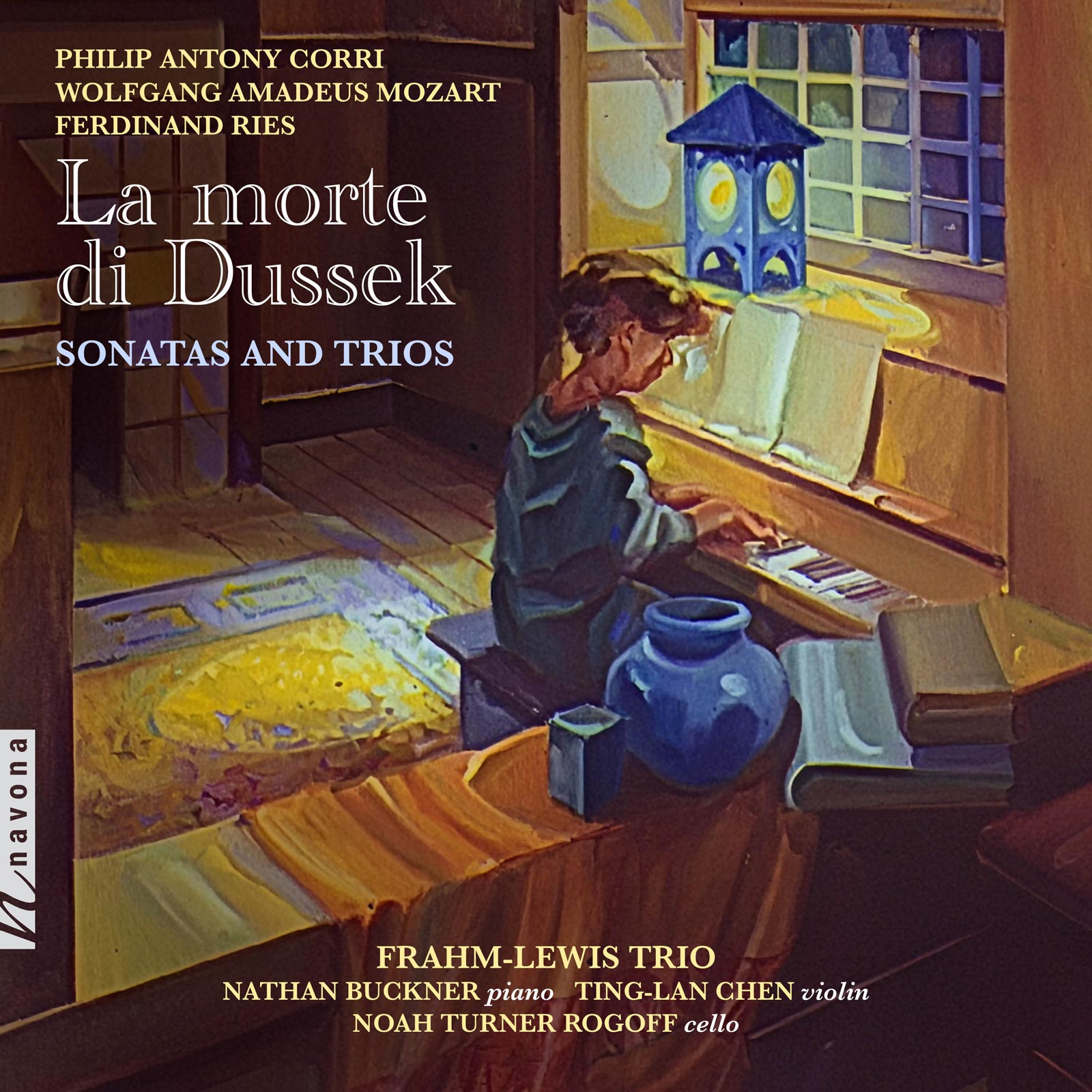La morte di Dussek
Philip Antony Corri composer
Wolfgang Amadeus Mozart composer
Ferdinand Ries composer
Frahm-Lewis Trio
Nathan Buckner piano
Ting-Lan Chen violin
Noah Turner Rogoff cello
The acclaimed The Frahm-Lewis Trio entices with LA MORTE DI DUSSEK. Contrasting the works of Mozart with the lesser-known Ferdinand Ries and Philip Antony Corri, it is a veritable declaration of love to the Classical era. One would be forgiven to think that the only star of this album would be Mozart, with his befittingly performed sonatas. Or perhaps its Beethoven’s student, Ferdinand Ries? After all, he graces this collection with an imposing trio highly reminiscent of his teacher’s early chamber works. A veritable trifecta is achieved with the addition of the album’s title piece by Philip Antony Corri, whose legacy intertwines with his sister’s marriage to the once famous composer Jan Ladislav Dussek. A historical oversight, for this premiere recording of his trio, translated as “The Death of Dussek,” is a clear focal point of this album — lyrical, beautiful, melodically elaborate, and harmonically innovative, almost as much as the works by the composer it commemorates.
Track Listing & Credits
| # | Title | Composer | Performer | |
|---|---|---|---|---|
| 01 | La morte di Dussek Elegiac Sonata in F minor: I. Allegro agitato e con espressione | Philip Antony Corri | Frahm-Lewis Trio | Nathan Buckner, piano; Ting-Lan Chen, violin; Noah Turner Rogoff, cello | 7:20 |
| 02 | La morte di Dussek Elegiac Sonata in F minor: II. Andante moderato | Philip Antony Corri | Frahm-Lewis Trio | Nathan Buckner, piano; Ting-Lan Chen, violin; Noah Turner Rogoff, cello | 5:46 |
| 03 | La morte di Dussek Elegiac Sonata in F minor: III. Finale: Non troppo presto ma agitato | Philip Antony Corri | Frahm-Lewis Trio | Nathan Buckner, piano; Ting-Lan Chen, violin; Noah Turner Rogoff, cello | 5:26 |
| 04 | Sonata in A Major, Opus 3/3, K.12: I. Andante | Wolfgang Amadeus Mozart | Frahm-Lewis Trio | Nathan Buckner, piano; Ting-Lan Chen, violin; Noah Turner Rogoff, cello | 3:13 |
| 05 | Sonata in A Major, Opus 3/3, K.12: II. Allegro | Wolfgang Amadeus Mozart | Frahm-Lewis Trio | Nathan Buckner, piano; Ting-Lan Chen, violin; Noah Turner Rogoff, cello | 2:24 |
| 06 | Sonata in E-flat Major, Opus 1/2, K.302: I. Allegro | Wolfgang Amadeus Mozart | Frahm-Lewis Trio | Nathan Buckner, piano; Ting-Lan Chen, violin; Noah Turner Rogoff, cello | 5:58 |
| 07 | Sonata in E-flat Major, Opus 1/2, K.302: II. Rondeau: Andante grazioso | Wolfgang Amadeus Mozart | Frahm-Lewis Trio | Nathan Buckner, piano; Ting-Lan Chen, violin; Noah Turner Rogoff, cello | 6:54 |
| 08 | Trio in B-flat Major, Opus 28: I. Allegro | Ferdinand Ries | Frahm-Lewis Trio | Nathan Buckner, piano; Ting-Lan Chen, violin; Noah Turner Rogoff, cello | 9:22 |
| 09 | Trio in B-flat Major, Opus 28: II. Scherzo: Allegro vivace | Ferdinand Ries | Frahm-Lewis Trio | Nathan Buckner, piano; Ting-Lan Chen, violin; Noah Turner Rogoff, cello | 5:04 |
| 10 | Trio in B-flat Major, Opus 28: III. Adagio | Ferdinand Ries | Frahm-Lewis Trio | Nathan Buckner, piano; Ting-Lan Chen, violin; Noah Turner Rogoff, cello | 3:44 |
| 11 | Trio in B-flat Major, Opus 28: IV. Finale: Allegretto ma non troppo | Ferdinand Ries | Frahm-Lewis Trio | Nathan Buckner, piano; Ting-Lan Chen, violin; Noah Turner Rogoff, cello | 6:58 |
Piano: Steinway & Sons, New York
Violin: Giuseppe Tarasconi, 1887
Cello: Wendy & Peter Moes, 2018
Publisher (Corri) Chappell & Co, London, 1816
Publisher (Mozart: K.12) Breitkopf & Hartel, Leipzig, 1879
Publisher (Mozart: K.302) Breitkopf & Hartel, Leipzig, 1879; Frahm-Lewis Trio, 2021
Publisher (Ries) N. Simrock, Bonn, ca.1810
Funding Source Frahm-Lewis Trio Fund
Tracks 1-3 & 6-7 Violoncello ad libitum by Frahm-Lewis Trio
Recorded July 21-22, 2022 at Studio M, Minnesota Public Radio in Saint Paul MN
Recording Session Engineer Cameron Wiley
Digital Editing Michael DeMark
Mastering Graham Duncan
Cover Art Mission Notes (oil on canvas; detail), Kay Lamoreux Buckner, 1996
Executive Producer Bob Lord
VP of A&R Brandon MacNeil
A&R Jeff LeRoy
VP of Production Jan Košulič
Audio Director Lucas Paquette
VP, Design & Marketing Brett Picknell
Art Director Ryan Harrison
Design Edward A. Fleming
Publicity Kacie Brown
Artist Information

Frahm-Lewis Trio
Nathan Buckner, Ting-Lan Chen, and Noah Turner Rogoff form the Frahm-Lewis Trio, which has served as the resident faculty piano trio for the University of Nebraska at Kearney since 2008. The ensemble has appeared in many of the principal performance venues throughout Nebraska, as well as in recitals in England, Malaysia, and the United States.

